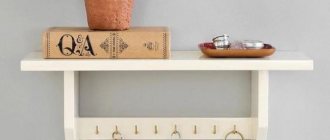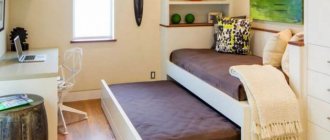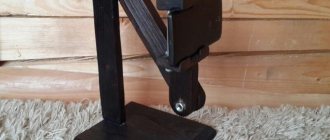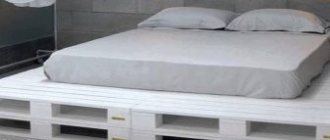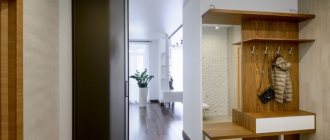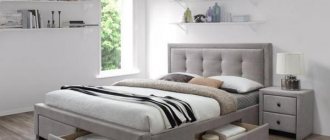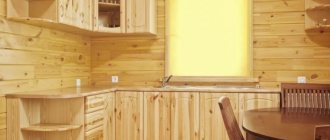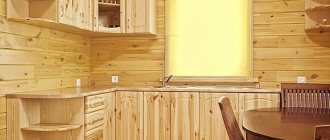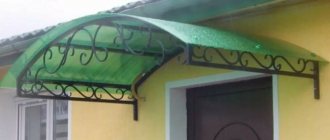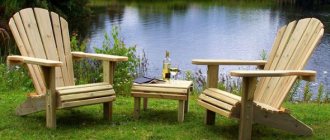A bench is simply necessary in a country house or garden. Its main purpose is a place to relax. Anyone who knows how to work should also be able to rest. Some people simply install a bench, while others create an interesting corner that will certainly invite you to have a good rest. You can simply relax, or you can simply enjoy the surrounding nature and the results of your work. There are many ideas worth considering. Of particular interest are ordinary designs that can be repeated by anyone familiar with wood and owning a primitive set of tools.
Photos of original benches (options for cottages and gardens)
Everyone can imagine what the most ordinary bench looks like, but not everyone likes simplicity and most opt for original solutions. Everyone wants to have something that, for example, a neighbor in the country does not have. Almost all summer residents start by decorating their summer cottage or garden plot, and there are also many options here. Alternatively, you can start designing the area by installing a bench, having previously decided on a resting place. After all, a place of rest is not needed later, it is needed now. Therefore, the design of this place should be tackled at the first stages of the process of decorating a summer cottage or personal plot, and only then proceed to the design of the rest of the territory.
As a rule, summer residents are very keen on growing various green spaces and flowers. Especially, there are a lot of them near buildings. Alternatively, you can combine plantings with a recreation area by installing a bench not far from the dacha. In this case, everything will look organic: green spaces, flower beds, and an original bench.
Two flower beds made of boards and a bench between them
There are a huge number of options: from the simplest to the most sophisticated. The simplest option may consist of two wooden boxes in which flowers are planted, and two boards built between these boxes. The boards must be planed and well sanded. This structure can be placed directly next to the wall of the dacha. You can attach a couple of the same planed boards to the wall, which will serve as a kind of backrest. Instead of wooden boxes, you can install concrete cabinets, which can last much longer than wooden elements.
Garden bench-flower bed
It is very simple to build such a structure, and most importantly quickly. As for the boards, you can buy them ready-made or make them to size yourself using untreated boards. But in this case, you will have to work hard, but the bench will not cost anything, and the result will definitely please you. If concrete flowerpots are used, the boards can be secured using metal corners. The only problem is the difficulty of drilling holes in concrete. Under no circumstances should you use a hammer drill, as a flowerpot, even a concrete one, will easily split, especially if it is made independently.
Flowerpots as legs
You can not fasten the boards, but instead of the boards put a huge log, which does not need to be fastened if it is installed correctly.
As mentioned above, there are many options, and they are created on the basis of the real possibilities that the owner of the dacha has. Alternatively, you can simply install a bench for relaxation away from flowers and green spaces. After all, it’s no secret that various insects hide in flowers and between the leaves of plants, which in no way encourage rest, but, on the contrary, force you to leave behind the worst memories of your holiday.
A bench made of boards is an interesting option
As a bench, you can use hollow blocks, into the voids of which treated boards are simply inserted, which can serve as seats.
Bench made of hollow blocks and timber
To make sitting comfortable, the sharp corners of the blocks should be rounded. It's good if these blocks turn out to be heavy and large. If the blocks are small, then they can be pinned together into one piece.
How to make a garden bench with your own hands
Preparing for work
Having decided on the material and location, you can begin to create a drawing of the bench. At this stage, the shape and dimensions of the product are determined. There are no strict rules here, but if you encounter difficulties, you can adhere to the following scheme:
- seat height – from 40 to 50 centimeters;
- width - from 50 to 55 centimeters;
- back height – from 35 to 50 centimeters.
If you want to make a bench with a back, then decide in advance how you will attach it to the seat. It also matters a lot whether you plan to reschedule it or not. In non-portable models, the legs are securely fixed to the ground.
The drawing will allow you to understand how much material will be required. Additionally, you need fastenings (nails, self-tapping screws, screws), primer and protective paint.
- DIY cornice: a detailed description of how to design and decorate a stylish interior element (80 photos)
DIY folding chair: 110 photos, drawings, diagrams and sketches of convenient and easy options for creating portable chairs
- Do-it-yourself pouf: step-by-step instructions on how to build a stylish and original interior element with your own hands (105 photos)
Log bench
The site can be decorated in any style, but almost everyone moves away from standard approaches to solving the problem. Everyone wants to have something of their own. But not everyone knows that what is new is an improvement on the old. As an option for a new, but somewhat improved old one, this is the option of using a log as a bench. As a seat, you can use a log of large diameter, sawn lengthwise. A log of smaller diameter, also sawn lengthwise, is used as a backrest. Or a trunk with a smaller diameter, but cut closer to the edge. Narrow sections of logs are used as legs.
Log bench - quick and easy
The legs and seats are connected to each other using metal pins. Holes of slightly smaller diameter are drilled for the pins. The pins must fit into the holes with force. In this case, half of the pin is driven in by hitting the pin, and the other half is driven in by hitting the wood. As a rule, they do not hit the wood itself, since marks from the hammer may remain, but with the help of a wooden point. Such a connection must be reliable, although there are many mounting options.
Bench option without backrest
In the photo just above, you can see another option, in the “ethnic” style. Its organization is associated with the presence of stone, although this option is quite feasible if there is a log. A fairly thick log is used as a seat, and a part of a large diameter log is used as legs. In one and the other part of the deck, grooves are cut for the seat. An ax or grinder is used as a tool. Alternatively, you can use a chainsaw. These are not post-Soviet “Friendships” or “Urals”, which have significant weight, and are, perhaps, convenient for felling pine trees in Siberia. If you take the Calm chainsaw into service, then with its help you can make even lesser works of art.
It is possible to make a table from logs, which is simply necessary in the country. In the photo you can see the results of such actions. The tabletop is made of boards, and the rest of the ensemble is made of logs of different diameters.
Table with log benches
The next bench, built in this style, has a completely original design. Here, the legs and armrests are made of branches of various thicknesses, and the seat is made of processed, high-quality unedged boards.
Option for a wooden bench for the garden or dacha
Another bench is made in the same style. The only difference is that the boards and branches have the opposite direction. The result is a completely different look. As for execution, no special skill is required. The more careless the end result, the more valuable it is. In any case, this is how others perceive this approach. Most likely, people are tired of imaginary perfection and they prefer handicraft and primitivism.
Wicker back - not often seen
Alternatively, you can organize a rest area around the tree and install a bench.
Relaxation area under a tree
This is not at all difficult if you install a swing and a gazebo nearby. It is better to build a pergola, similar to an arch, above the bench itself. All that is missing for a complete relaxation is a pond, fountain or waterfall.
Product types
Wooden benches vary in design and installation location. First of all, they are stationary and mobile. The first option is a static piece of landscape design, while the second can be moved and mounted anywhere. Based on their design features, the following types of products are distinguished:
- Street. Most often they are made according to a standard design and rarely feature original shapes, but they are durable and functional. They can be found in parks and squares.
- For garden. Products may contain additional metal parts, openwork designs, decorative elements, and carved figures. Such a bench decorates the garden and makes the space functional.
- Country houses. They are distinguished by species diversity.
- For the bath. Here the design can be simple, stepped or in several tiers. This bench is intended for sitting or lying and is not distinguished by its decorative variety.
street
For garden
Dacha
For the bath
There are several types of products based on location. They all have distinctive features. The main varieties and their characteristics are presented in the table.
| Varieties | Characteristic |
| Front doors | Mounted near the porch at the entrance. They are often decorated with carvings or forged decorative elements. |
| Dining | Required where the family gathers around the table: on the terrace, at the barbecue. Wood of different species is used to make products. |
| Seasonal | They are mobile and can be moved from one place to another; for the winter they are put away in a room protected from moisture. |
| For installation near a pond | Their manufacture requires wood species that are resistant to moisture. Additionally, they are treated with protective compounds that prevent the material from rotting. |
Front door
Dining
Seasonal
For installation near a pond
A wooden bench with a back is considered the simplest; you can make it yourself.
You can often find unusual products: corner ones, with cut elements, folding ones, with drawers for storing things. Original models with bizarre curved shapes, unusual legs made of tree branches, and an asymmetrical seat will make the exterior individual. Designer benches are one of a kind, but they are quite expensive.
Corner
carved
With storage box
From the branches
Curved shape
Designer
Benches made of metal and wood
As a rule, no one decided to build a bench out of metal. In the summer, they can heat up to such temperatures that it makes no sense to talk about rest at all. In case of cold weather, the picture is the same. The bench becomes so cold that it is impossible to sit on it. But benches using a combination of metal and wood are the most in demand. As a rule, the frame is made of metal, which ensures high reliability of the structure, and the seat and back are made of wood, which provides a certain comfort.
Bench made of profile pipe
If the design is improved and soft armrests, soft seats and backs are made, as in the photo, then such a design can compete with the most modern options for rest benches. To make the seats, armrests and backrests soft, it is enough to cover furniture foam rubber with a suitable material. In this style it is possible to build a tabletop.
On a note! When using wood, it is advisable to leave gaps of up to 5 mm between individual elements. This is due to the fact that when the ambient humidity changes, the dimensions of the elements also change.
Stylish benches made of metal and wood
In the process of creating a seating area, care should be taken to ensure that there are no sharp corners, especially in metal structures. This is very important if you have children. All elements of the ensemble, such as benches, tables, garden chairs, are made from round and square pipes, bending them so as to create smooth transitions.
Table and bench made of pipes and boards
The presence of metal allows you to bend structures of any shape, although this cannot be done so easily and you need a special device. The presence of such capabilities allows you to bend structures in one go, without using other tools, such as a grinder and a welding machine. The main thing is to think through the design down to the smallest detail. If wood is used, then only well-processed wood. Wooden elements should not be allowed to have burrs or chips.
Materials
- Wood is the most common material for making benches: it is easy to process, has low weight, relatively low cost, elements can be easily replaced if desired, and is environmentally friendly. The disadvantages include the fact that wood is susceptible to environmental influences, and without special preparation it will not last long.
- In second place in popularity is the combination of a metal frame and wooden cladding. Here, to make a frame, you can use a metal corner and small diameter pipes.
- Composite materials are less in demand, but are not inferior in strength and durability.
- Plastic - used relatively recently, is not reliable, but has resistant properties to changing weather conditions.
- Materials of other origin - granite, concrete, construction waste, etc.
Benches made of boards
The most popular option is benches made of boards. There are quite a lot of execution options. There are even designs that look like sofas. If you put soft pillows on them, you can lie down.
This garden bench is more like a sofa: if it is of sufficient size, you can lie down
Garden furniture designs, based on a modern approach, are assembled simply. As a rule, they consist of rectangles with partitions made of thinner wood, connected together into one whole.
If you stretch your imagination and put it to work, you can build a work of art from an ordinary bench if, for example, you install wooden wheels instead of legs and armrests.
A bench made of boards with a back and wheels instead of sides - looks interesting
One of the simplest designs of a country bench consists of one board, to which legs are attached in the shape of the letter “X”. Our ancestors built similar shops, although they can still be found today.
Traditional bench design
Using wood, you can build a bench in the shape of the letter “P”. In this design, it is very important to ensure reliable fastening of the seat and legs. This option involves the use of a thick board or timber for reliability. As an option, you can install the board “on edge” for greater rigidity, and for greater reliability it is recommended to fasten it using metal corners.
This photo shows an option where the cut is made at 45 degrees. This is not difficult to do with the help of a special tool. If you connect all the parts, you get an angle of 90 degrees. If the board is thick and the seat does not sag, then the bench will last quite a long time.
In the photo below you can see another option for an interesting solution, which is characterized by increased reliability. Boards of different lengths are used as legs. The difference in length is the thickness of the board: every second board should be shorter. The structure is connected using nails. Moreover, through one board, the nails are driven either into the board for the seat or into the board for the legs.
Modern style bench
Construction type
A lot of time has passed since the invention of the bench, its original appearance was constantly changing: new elements were added, the shape was transformed, new materials were used...
The most common options for do-it-yourself garden benches are:
- A bench combined with a table - the table can divide the seating in the middle, or is located on the edge;
- Wooden bench with back – the usual shape is complemented by a high back;
- A bench combined with a flower bed.
- The compact version for a picnic is a prefabricated version that can be assembled and disassembled without much effort when not needed.
- A bench mounted around a tree trunk is a very popular version, the tree is enclosed by a diamond-shaped or square-shaped bench.
- Bench with a roof – the structure has a roof.
- In the form of a swing - a hanging option.
- No backrest.
- In the form of a sofa.
In most cases, preference is given to mobile versions, which allow you to move the bench without much effort, although this is not always the most optimal option.
Original solutions
Along with the classical approach to the process of making benches, there is also an original one, although solving such a problem requires appropriate materials and tools.
For example, you can also build a bench from a large stone if you attach an appropriate wooden platform to it.
Bench made of stone and boards
If bamboo is available, a seat is also made from it, which will take on a more exotic look.
Made from bamboo, and whole
Or a stone.
Sitting in winter will be unpleasant, but beautiful...
It all depends on the flight of fancy. A real owner does not have unnecessary things or materials in his dacha. With a reasonable approach, you can attach any thing, and it will not just lie around in the country or lie like a dead weight in the garage or shed.
Bench with table
It’s a good idea to place a comfortable bench with a small table on the terrace or in the gazebo.
To work you will need:
- boards 40 x 140 mm thick, 40 x 80 mm, 25 x 80 mm,
- wood glue and nails,
- jigsaw,
- drill,
- Miter saw,
- screwdriver,
- roulette.
Operating procedure.
- Cut two blanks 60 mm long, two 58 mm long from the boards.
- Cut grooves in the blanks and make L-shaped elements.
- For the frame, cut out four parts of equal length and attach to the side bases.
- Four 60 mm backrest elements are attached to the base.
- The frame is covered with slats.
- It is recommended to varnish or paint the product.
How to make a bench: photo reports
Naturally, not every owner has a set of tools for making benches from stone, but everyone has a minimum set of tools for working with wood, especially since these are very simple and affordable tools. Therefore, it makes sense to consider wood structures. Everything that is done with one's own hands is ultimately a source of pride.
Bench without back
The design, although simple, has a rather impressive appearance due to the material used. The legs are made from timber with rounded edges. As a last resort, such a beam can be prepared independently from round logs of small diameter, trimming them on 4 sides. The result will be the same timber. Therefore, there should be no problems with the construction of the bench. The legs of the bench will be made from this material. To do this, you should lay the cut beams flat (horizontally) one on top of the other. It is this design solution that brings a certain exclusivity to the design.
A simple bench looks interesting due to the material
The bench without backrest is 120 cm long, 45 cm wide and 38 cm high. It is permissible to round the edges of the beam in any way. In order not to strain too much, you can already find a ready-made, profiled beam. Although it will cost much more, it is a pleasure to work with it.
Depending on the size of the bench, it is not difficult to calculate how much timber is required. If you take a beam with a cross-section of 70x70 mm, then with a height of legs of 380 mm, it is enough to place 5 beams on top of each other. We calculate: 45 cm multiplied by 5 pieces. and you get 2.25 m of timber. Since there are 2 legs, there will be 2 times more timber, which means 4.5 meters of timber. A board 40 mm thick and 90 mm wide is used as a seat. Given the width of the bench, you will need 5 boards, 1.5 meters long. If you calculate more accurately, you will need 1.2 m x 5 pcs. = 6 m of board.
At the first stage, boards are cut according to size. In this case, it is necessary to round off all sharp edges. To do this, you can take a plane or just coarse sandpaper and carefully process the boards. In order not to have to do much yourself, there is another option: you can simply negotiate at the sawmill and get a well-processed board, especially since they have all the capabilities for this. All that remains is to take them and coat them with varnish.
Treated boards
After this, they begin to manufacture the legs, for which the beams are cut into identical sections, 45 cm long, after which they are stacked one on top of the other in 5 pieces. The next stage is connecting the legs for stability. In this case, the beams can be fastened with metal pins or wooden dowels. The distance between the fasteners is 7-10 cm. As a rule, such a connection is made using glue, then the connection is more reliable.
Lines where the pins will be installed
The pin connection requires precise drilling of the holes, otherwise the beams will not be on the same line. For this, it is better to use a template. In addition, the dimensions of the leg elements must be the same, then it will be possible to accurately mark the location for drilling holes. For those who are familiar with drawing, tape measure and pencil, it will not be difficult to do everything correctly.
We make holes in the bars in a checkerboard pattern
The pins should be installed in a staggered pattern, so it is necessary to mark with this feature in mind. In the same way, the boards are attached to the legs at the rate of two holes per board.
If you look from a technological point of view, this is not a bad connection option, but it requires some skill and experience in working with wood. The connection stage can be simplified if the bars for the legs are stacked one on top of the other and firmly connected them using a clamp. Then drilling accuracy will be ensured. Alternatively, the beams can be connected using long metal pins and nuts with washers. In this case, it is enough to drill 2-3 holes through.
The seats can be nailed to the legs, which greatly simplifies the entire manufacturing technology of such a bench.
The bench is made by hand. Finishing work remains
When using nails, it is advisable to hide the heads, as they will then rust, which is completely undesirable. To do this, hammer the nails so that the heads are hidden almost 5 mm deep into the wood; for this, you can use a guide. After this, putty is taken, a little sawdust is added to it to match the color, and the recesses are puttied. After complete drying, the areas are carefully sanded with sandpaper. So that the place where the nails are driven does not stand out against the general background, they are coated with a suitable varnish.
The technology for varnishing wooden surfaces is quite simple, especially since it is described in detail in the instructions for use.
Decoration
Wood is a strong and durable material, but under the influence of external factors it can deteriorate, rot, and develop mold and mildew. For protection, you need to purchase an antiseptic impregnation, which will prevent the occurrence of the problems already mentioned, as well as damage to the product by insects. Good compositions produce a complex effect. They contain oils and wax. Some of them are used instead of decorative coating.
If there is no impregnation, then a primer with antiseptic properties will do. Its advantage is that it strengthens the adhesion of the finishing coating to the base. Before processing, the bench must be cleaned of dust and sanded with fine sandpaper. Usually the procedure is repeated 2 times. If the bench is used in a bathhouse, then it should be additionally treated with fire retardants. And in order for it not to darken, it must be coated with a bleaching compound containing strong oxidizing agents.
Any piece of furniture should be not only functional, but also visually attractive. If you need a decorative bench, there are several main ways to decorate it:
- Coloring. The following types of compositions are used here: water-dispersion, alkyd or polyurethane enamels, oil paint, water-based or polyurethane varnish. Important criteria for choosing a material are its safety, resistance to external factors, and the absence of chemical components. The composition must be intended for wood processing.
- Painting. For this purpose, artistic acrylic compositions are used. The product is first coated with white paint. After it dries, a pattern is marked on the base. After painting is completed, 1-2 layers of clear varnish are applied to the bench.
- Thread. The carved bench looks very impressive. Moreover, in this way you can decorate any part of the bench. It is also allowed to install additional elements, figurines of fairy-tale characters.
- Decoupage. Here you can use napkins with a pattern, plant leaves. The work also requires glue and a brush, a sponge, and scissors.
A beautiful wooden bench is a common element of landscape design intended for relaxation. The manufacturing material allows even the most daring projects to be realized. An exclusive handmade item will help create an atmosphere of comfort and warmth in your area.
Coloring
painting
Thread
Decoupage
Bench for a summer house made from broken chairs
If you have two old chairs and don’t have enough imagination to adapt them somewhere, then you can make a bench out of them. Only the same ones and strong enough will do. If they are loose, they will have to be repaired. The chairs are disassembled so that the backs and legs remain. After this, two chairs, or rather what is left of them, are installed side by side and their backs are connected using slats of the appropriate thickness.
Bench made from old chairs
To make the structure rigid, at a height of 20 cm from the floor, the structure is tied with the same slats along the entire perimeter. Subsequently, these slats will serve as a footrest, and if the bottom is sewn up, for example, with plywood, then you can store some things here.
We paint the completed structure
After the structure has been strengthened and sanded, it can be painted. In this case, ordinary paint is suitable, which can hide some flaws in the entire structure and especially in old chairs. All that remains is to cut out a sheet of plywood, lay foam rubber on it and cover it with some fabric. At the same time, one should take into account the fact that the bench will mainly stand outside until the coldest weather. Therefore, it is better to opt for, for example, leatherette. In any case, the material must be moisture resistant.
Finished bench made from strusses
Useful tips
We know how else you can decorate your site! We recommend reading our material on the topic – Hedge (fast-growing perennial evergreen).
Experienced craftsmen use some techniques to speed up the assembly or finishing of finished products. Let's look at some of them:
- Assembling metal benches with bolts allows , if necessary, to disassemble the structure and reuse the resulting material. At the same time, the nuts must be reliably protected from rust so that they do not have to be cut off.
- To make finishing easier, it is recommended to paint the parts before assembly . This applies to wood backs and seats attached to a metal frame, or other components that do not require welding. At a minimum, a first coat of coating is applied, although a full finishing can be done.
- When manufacturing heavy parts (concrete castings, massive welded supports for long structures), it is recommended to carry out work as close as possible to the installation site so that you do not have to carry the finished product over a long distance.
Garden bench chair made from pallets
For a reasonable owner, any material has its own value. Garden furniture can be made from cargo pallets without any problems. Moreover, there is no particular need to disassemble them: the back is made from one pallet, and the seat from the other. All that remains is to think about what to make the armrests and legs from.
This is what should happen
One of the pallets is reinforced with additional bars, which are secured with self-tapping screws.
Strengthening the corners of the pallet
After this, a beam with dimensions of 100x100 mm and an arbitrary length is taken, after which 4 identical sections are cut, up to 80 cm long. They are attached in those places where the reinforcement bars, placed in advance, are located. As a result, legs 20-25 cm long will be sufficient. Self-tapping screws with a length of at least 150 mm are used for fastening. During the work, you need to make sure that the bars are screwed correctly so that you can install legs of the same length.
Screwing the legs-supports for the armrests
If after these steps it is not possible to obtain a completely flat structure, then the legs can be filed at the end if the bench does not sit level.
The legs are screwed
The second pallet is attached to the rear pillars, and on both sides there are boards for the armrests.
Almost done
Further - as necessary. If you want to have upholstered furniture, then just buy foam rubber, cut out the required piece and cover it with moisture-resistant material. You can do the same with the back.
If there are no such plans, then you can simply carefully process the wooden elements with sandpaper, after which the bench is simply painted with any paint, any color.
Finished product: pallet chair
Unusual benches
With some creativity, it’s easy to make an unusual bench for relaxing in the fresh air.
The garden benches surrounding the trunk of an old tree, which will create the necessary shade on a hot sunny day, look original.
The country bench can be equipped with original flowerpots along the edges.
If desired, you can make an interesting children's bench in the form of a figured puzzle.
The bench can be supplemented with elements of artistic forging.
When making benches for relaxation, you can use old furniture, transport pallets, chests, and so on.
It is important to take care of safety, so it is recommended to make the edges of the product rounded and carefully treat the surfaces.
A bench made independently will best meet all the individual requirements of the site owners and will perfectly complement the landscape.
